Hogfish is a species of wrasse with an unusually flat and oval-shaped body compared with other wrasse species. It is native to Western Atlantic Oceans and regarded as a food fish due to its taste.
Hogfish may look like a usual fish, but it has many interesting secrets you may not know. So, before tasting your hogfish dish, let’s find out about their exciting facts.
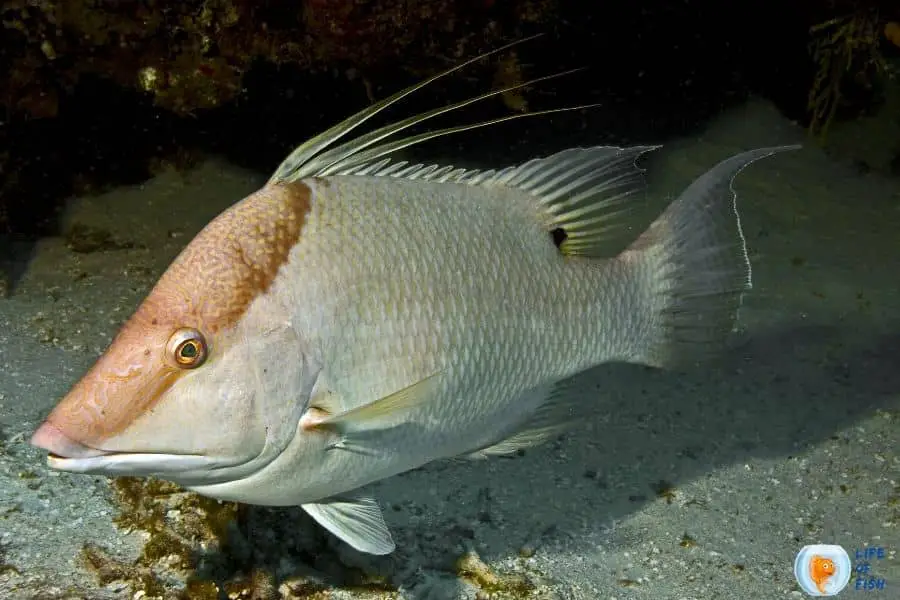
What is Hogfish?
Jump To
- 1 What is Hogfish?
- 2 How Hogfish looks like
- 3 Where Hogfish live?
- 4 Hogfish behavior
- 5 What do Hogfish eat?
- 6 How do Hogfish reproduce (Hogfish breeding)
- 7 Importance of Hogfish
- 8 Are Hogfish dangerous?
- 9 Why is Hogfish so expensive?
- 10 What is hogfish taste like?
- 11 Are Hogfish poisonous?
- 12 Are Hogfish good to eat?
- 13 Where do you catch Hogfish?
- 14 Related Questions
- 15 Conclusion
Lachnolaimus maximus, commonly called hogfish, boquinete, doncella de pluma, or pez Perro, belongs to the Labridae family, which is related to different fish such as fish wrasse, damselfish, and parrotfish.
They live in the coastal western Atlantic Ocean from North Carolina to Bermuda and south throughout the Gulf of Mexico and the Caribbean Sea.
Hog fish inhabits reefs or shallow waters at depths of up to 100 feet, prefer inshore rocky or coral reefs and lagoons.
They can be found in most of the Bahamas, Cuba, and some parts of Mexico.
The original scientific name for Hogfish was Labrus maximum (Walbaum, 1792). But, taxonomists later changed the name to the current one, Lachnolaimus maximus (Walbaum 1792).
The term Lachnolaimus is derived from the Greek words “lachne, -es,” which means “covered with more hair than others,” and “laimos,” which means “throat.”
How Hogfish looks like
Although It is a wrasse, it is closely related to parrotfish. Therefore, it has a unique appearance than of other wrasses.
Color
Hogfish change their color in different stages of life. Juveniles and female fish have pale grey, brown, or reddish-brown bodies with no distinct patterns.
The underbelly is also paler in females and juveniles. The general color of these fish is pearl white with brownish-red spots and a black spot just before the dorsal fin. All Hogfish has a bright red colored iris.
Mele fish are more intensely colored than females. They are gray-brown in color with a dusky to dark spot at the rear base of the dorsal fin.
The pectoral fins of the male fish are yellow. The outer margins of the soft dorsal, anal, and caudal fins are colored in black.
Shape
They have a rounded, high, large, and laterally compressed body. Their shape is different than other wrasses, which have a smaller and cigar-shaped body.
The caudal fin is semicircular, and the first three dorsal fin spines are elongated and thickened. The tip of each of the dorsal fin and anal fin is pointed.
They have an elongated, pig-like snout that is used to root around the substrate for prey. This is why they are named Hogfish because of their snout and rooting behavior.
Size
A fully grown hogfish size is about 3 feet (91cm), and they can reach about 11 kg (24 lb) in weight.
Life span
The maximum recorded lifespan of Hogfish is 11 years.
Male and female fish
They have sexual dimorphism, meaning males and females are not similar in either shape, color, or size. Females usually tend to be paler than male fish.
Males have colors that are more intense and darker mainly because of their breeding coloration.
They also have a bright black-colored fleck behind the pectoral fins, which extinguish males from females.
Females are usually pale grey, brown, or reddish-brown, while males are gray-brown, with a distinct black spot and yellow pectoral fins.
The outer margins of males’ soft dorsal, anal, and caudal fins are colored in black.
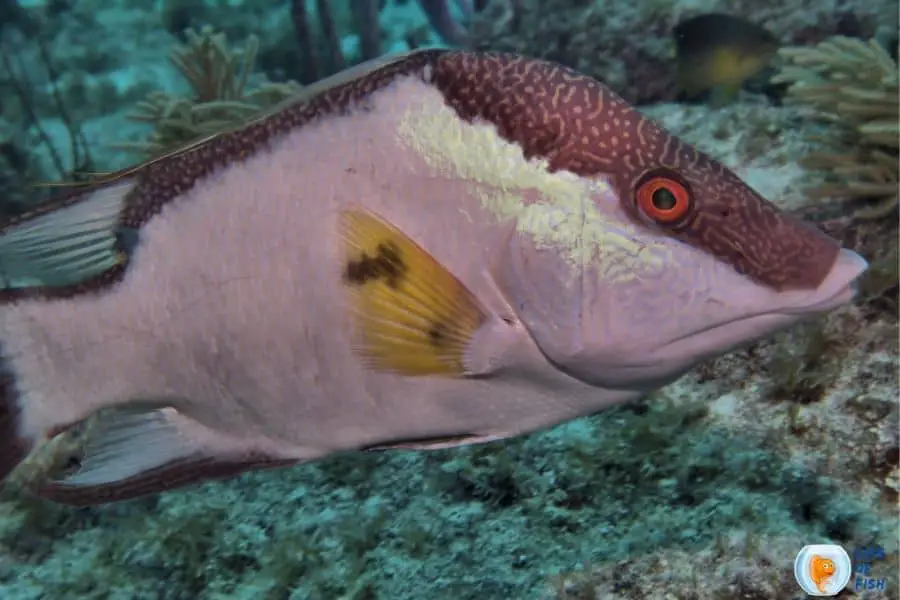
Where Hogfish live?
They inhabit the Western Atlantic Ocean, from Bermuda and North Carolina, through the Gulf of Mexico and Caribbean sea, to the north coast of South America.
They are ubiquitous in Florida waters and shallow waters of the islands of the Caribbean. In Florida Bay, juvenile Hogfish are commonly found in seagrass beds.
They reside on the open bottoms and coral reefs at depths up to 100 feet (30m). Hog fish often live in soft coral areas.
They are typically found along the reef’s margins, congregating in small groups.
It prefers hard sand and rock bottoms within a few feet of shallow patch reefs just offshore and inshore from the major reef structure.
The majority of the fish are small, while a few are large. The main reef area has larger individuals, while smaller fish can be found among the patch reefs.
Hogfish behavior
They are forage fish that are solitary and territorial. They feed on small invertebrates, such as mollusks, crustaceans, worms, tunicates, and other small bottom-feeding fishes.
These fish root around in the substrate like pigs, searching for food.
This species spends most of its time rooting around in the substrate. Hogfish are most active in the daytime when they prey on worms, crustaceans, tunicates, mollusks, and small fishes that reside in the bottom.
During the nighttime, they tend to remain inactive and rest on a shelter or rocks. They occasionally form loose schools that consist of about six to eight fish each. The contact among the group is minimal.
What do Hogfish eat?
They feed on small invertebrates, such as mollusks, crustaceans, worms, tunicates, and other small bottom-feeding fishes.
How do Hogfish reproduce (Hogfish breeding)
They are Sequential hermaphrodites. This means that they start as females and then change into males after they reach a specific size.
A hogfish can’t change the sex on its own; it needs the presence of another hogfish to change the sex.
Oftentimes, the male specimen is selected through social dominance, and it occurs when these fish reach three years of age and surpass the length of 14 inches (35.5cm).
These fish reproduce during the months of February and March in South Florida waters.
They gather in schools with one dominating male and more females, which is referred to as harem. The male Hogfish guards his harem and spawns exclusively with the females in his harem.
They spawn in the later afternoon and early evening. The male approaches the female, who is usually resting on her back or belly, and engages in courting.
Then the breeding pair rush toward the surface and spawns. Hogfish are external spawners. The male fish fertilizes the eggs while the female lays them into the water.
The fertilized eggs hatch within 24 hours and release free-swimming larvae.
The larvae stage lasts a few weeks until they transform into juveniles and find suitable habitats on the sea. Juvenile Hogfish often inhabit seagrass beds until they mature.
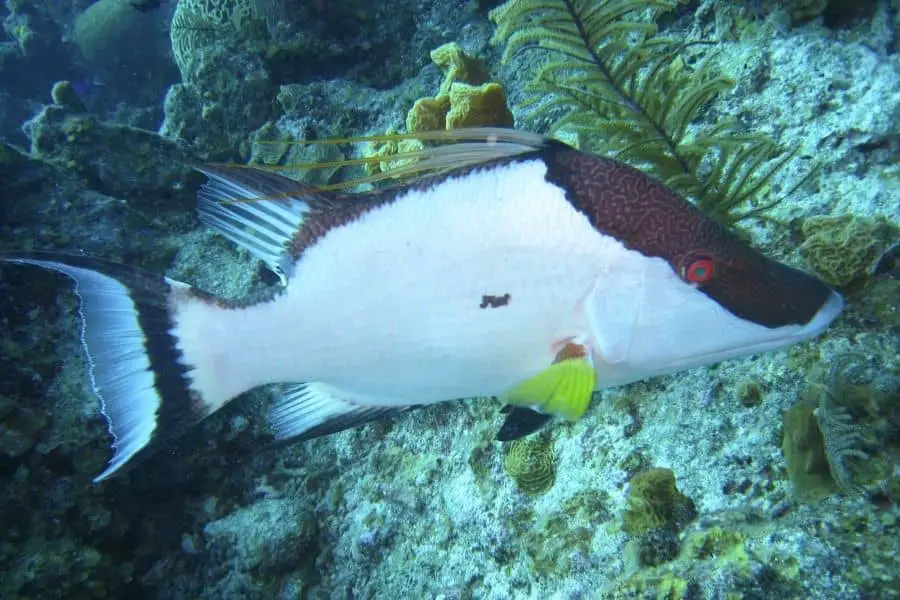
Importance of Hogfish
Ecosystem balance
They are secondary consumers of the ecosystem. They predate on smaller invertebrates, which in turn prey on bacteria, ensuring the balance of the ecosystem.
The predator of Hogfish includes larger bony fishes and sharks.
As a food
Hogfish is a popular seafood in Florida and throughout the Caribbean. It has a light, flaky texture and a delicious flavor. The fish is also very versatile and can be served as steaks, fillets, or whole.
The commercial fishing industry actively targets Hogfish because of its delicious taste. The species is a common catch of the trawler, purse seiner, and other commercial fishing methods.
Sportfishing
Hogfish is a popular species for sport fishing because they are strong, fast, and feisty. They put up a good fight when hooked and often jump off the hook when they feel threatened.
Hogfish is classified as a game fish. Since the species has a fight, sport fishers enjoy targeting them using either rod and reel or hand lines.
Aesthetics
Hogfish are appealing because of their bright colors and unique facial features. The bright orange and red stripes with irregular black spots make Hogfish a popular fish to raise in commercial aquariums.
Furthermore, its protruding jaw adds more character to the fish.
Are Hogfish dangerous?
Hogfish are not dangerous as fish, but their flesh has been linked to ciguatera poisoning.
Ciguatera poisoning affects the nervous system of humans and causes gastrointestinal distress, among other symptoms.
Like any other food-grade ree fish, Hogfish is a primary source of ciguatera poisoning that affects humans.
Thus, it is advisable to avoid eating hogfish fillets with dark or greenish spots because the flesh of the fish is dangerous to eat when it has not been properly processed.
It is also best to avoid eating Hogfish that are caught in unusual areas. Ciguatera poisoning is attributed to the consumption of reef fish that feed on algae containing ciguatoxin.
Ciguatoxin can contaminate the flesh of the fish even if they are not directly in contact with contaminated algae.
Why is Hogfish so expensive?
Hogfish are expensive because of their limited supply. Furthermore, the demand for these fish is also high because of their delicious taste and nutritional meal value.
Hogfish are fished commercially. Like any other type of seafood, Hogfish are scarce in supply.
The commercial fishing industry is not always able to catch the right amount of Hogfish that can satisfy the demands of its consumers.
Hogfish populations have been severely reduced because of overfishing. The fishing industry has been unable to keep up with the demand for Hogfish because their population is being depleted quickly.
As a result, their price has increased significantly. Because of their scarcity, Hogfish are very expensive compared to other types of fish caught off the coast of Florida.
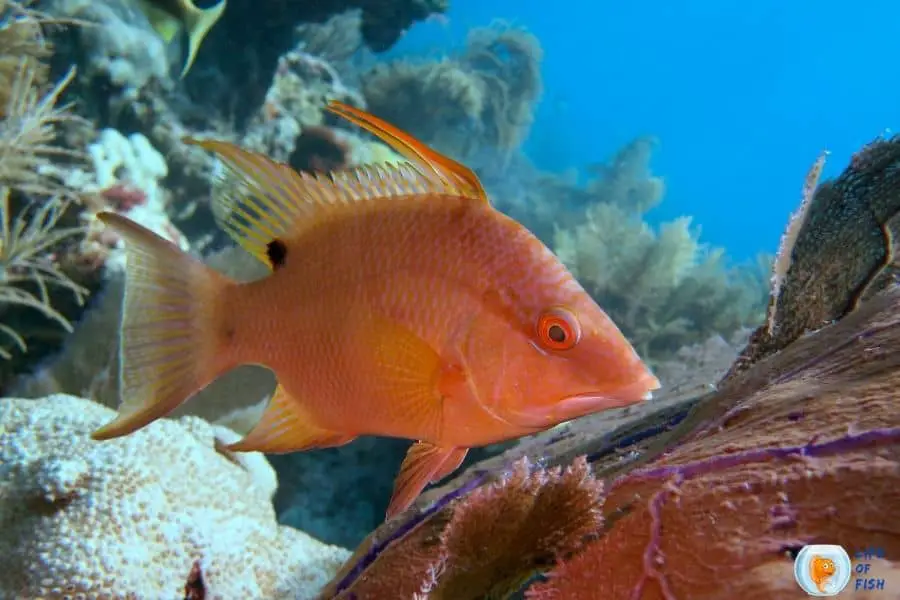
What is hogfish taste like?
Hogfish are among the tastiest cooked fish in Florida. It has a mild flavor with sweet traces and a flaky texture that makes it easy to cook.
The fish is not bony, which means you can eat the meat without taking out the bones.
Hogfish is delicious because of its mild taste and flaky texture. This fish is usually filleted and fried but can also be cooked in other ways, such as steaming or baking.
Are Hogfish poisonous?
Although Hogfish are not poisonous, they can be poisonous if they have consumed toxic algae before catching.
Ciguatera poisoning occurs when the fish has consumed toxic algae, which can make its meat poisonous to humans.
Ciguatera poisoning is common in any reef fish, and Ciguatoxins may cause abdominal pain, vomiting, nausea, and diarrhea in humans.
Unfortunately, it is difficult to tell if the fish is contaminated with this toxin. Further, the toxin can not be destroyed by any food preparation method like cooking, smoking, salting, freezing, etc.
You can prevent Ciguatera poisoning by not eating reef fish over 6 pounds and removing the liver, heads, intestines, and roe of smaller fish.
Are Hogfish good to eat?
Apart from the risk of Ciguatera poisoning, Hogfish is an edible fish and is very delicious.
These fish are not popular outside the Florida Keys. But those who know the taste of hogfish claim that it is delicious.
Where do you catch Hogfish?
You can often catch these fish in Apollo Beach, Indiana Rock Beach offshores of st. Petersburg and in the Florida Middle Grounds.
Since these fish primarily feed on crustaceans, you can use shrimps as bait to catch Hogfish.
Hogfish are found near the shorelines of the Florida Gulf coast and deep waters. The species can be caught near the shorelines during summer and near Florida Middle Grounds during autumn.
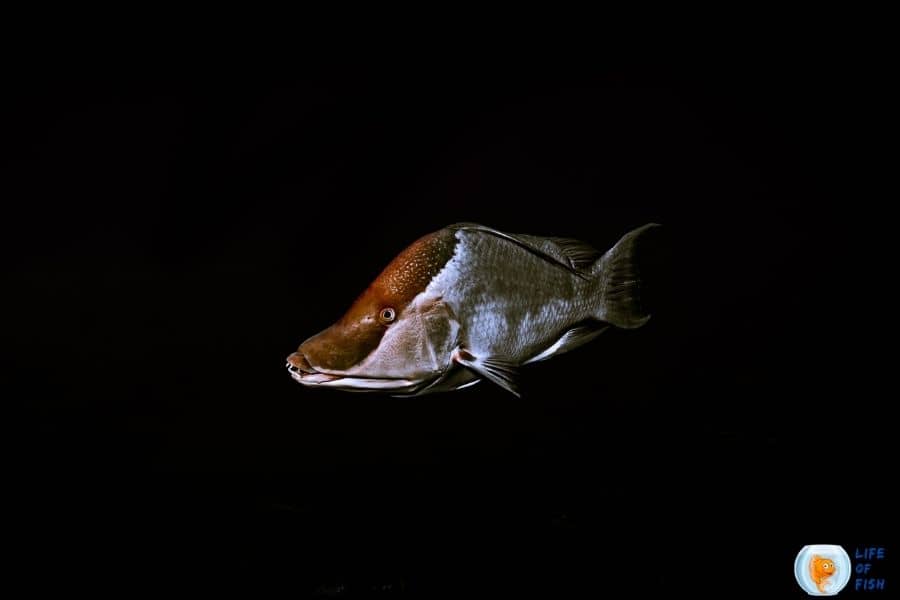
Related Questions
What kind of fish is a Hogfish?
Hogfish is a wrasse species but mostly related to parrotfish considering their appearance. They are native to the Western Atlantic Ocean and inhabit reefs and areas with gorgonian populations.
Is a hogfish a snapper?
Although Hogfish are also called hog snapper, they are not related to snappers at all. They belong to the wrasse family and is the only known member of the Lachnolaimus genus.
How is a hogfish different from a Grouper?
Hogfish are not part of the grouper family, but people often mistake them for being grouper because of their looks.
Hogfish belong to the family Labridae, while Groupers belong to the family Serranidae. Groupers also usually inhabit coral reefs, but they are quite larger than Hogfish.
How long do Hogfish live?
Hogfish can live for about 11 years and reach an average weight of 24 pounds.
Are Hogfish rare?
Hogfish are not rare as they are among the most common types of fish in Florida waters. However, their population is declining due to overfishing.
The IUCN Red List of Threatened Species considers Hogfish as a Vulnerable species.
Conclusion
Hogfish is a visually appealing food fish with an interesting life cycle and behavior. They inhabit reefs and gorgonians’ abundant areas in the Western Atlantic Ocean.
As these fish are regarded as a delicacy in the Florida Keys, they sell for higher prices due to low supply.
Although they are not popular outside this area, they are one of the “must taste” fish if you ever visit Florida.
Read Next: Humphead Glassfish (Parambassis Pulcinella) | 15 Amazing Facts
